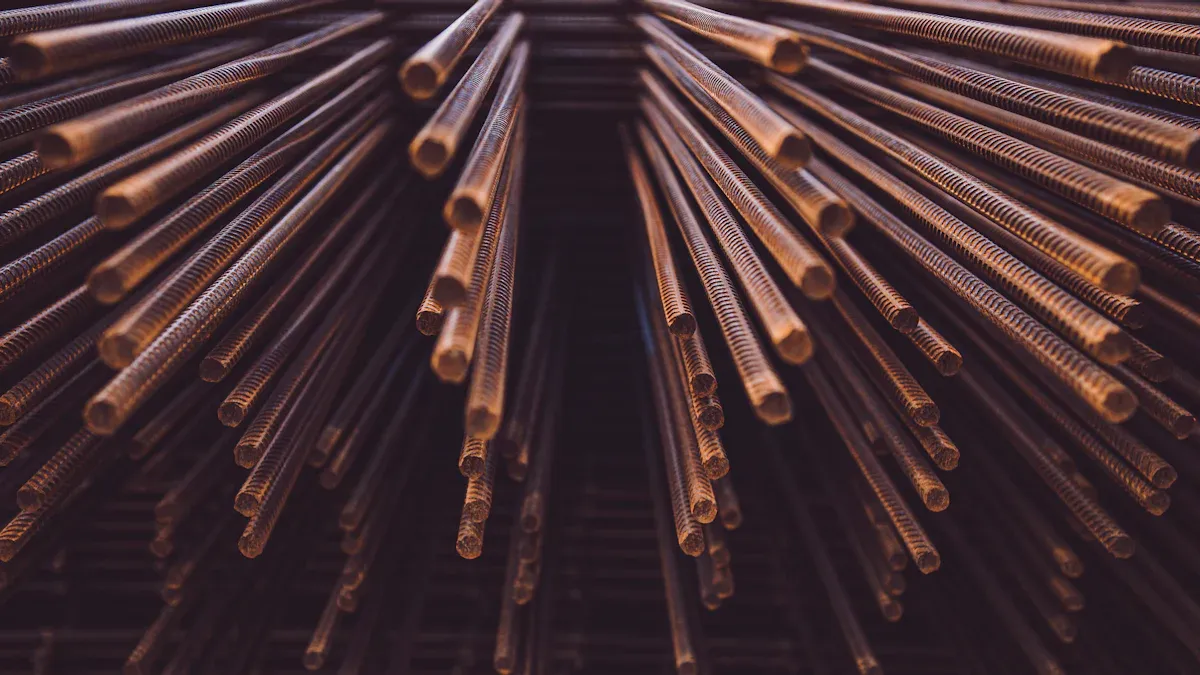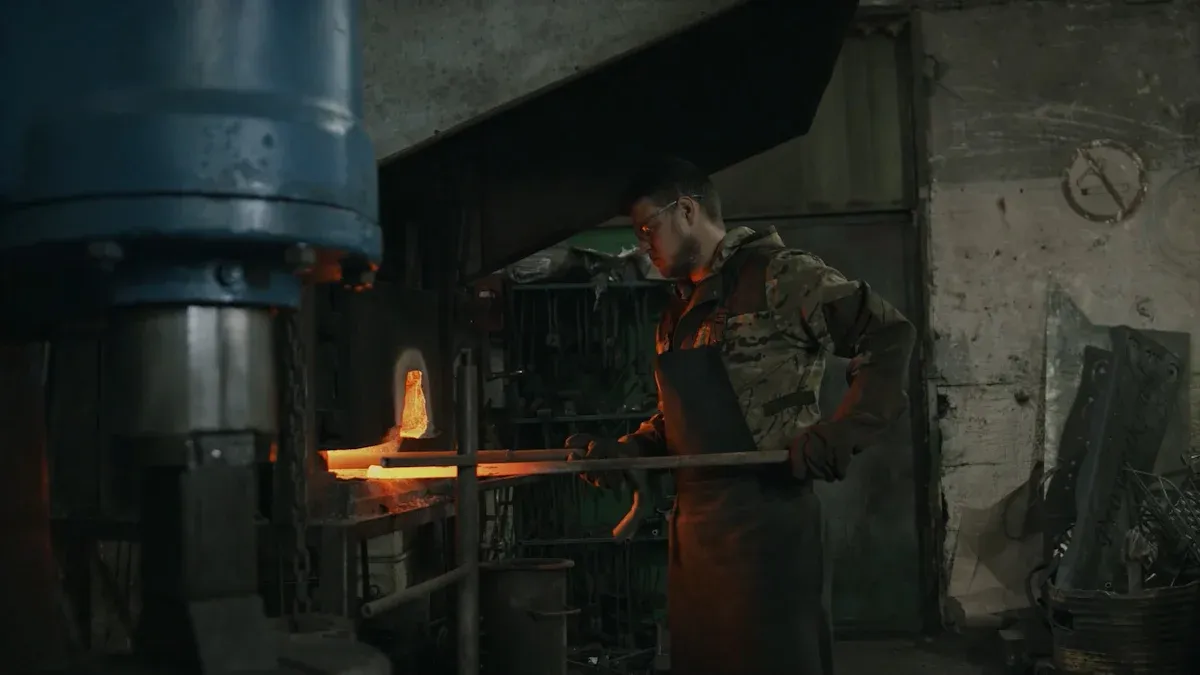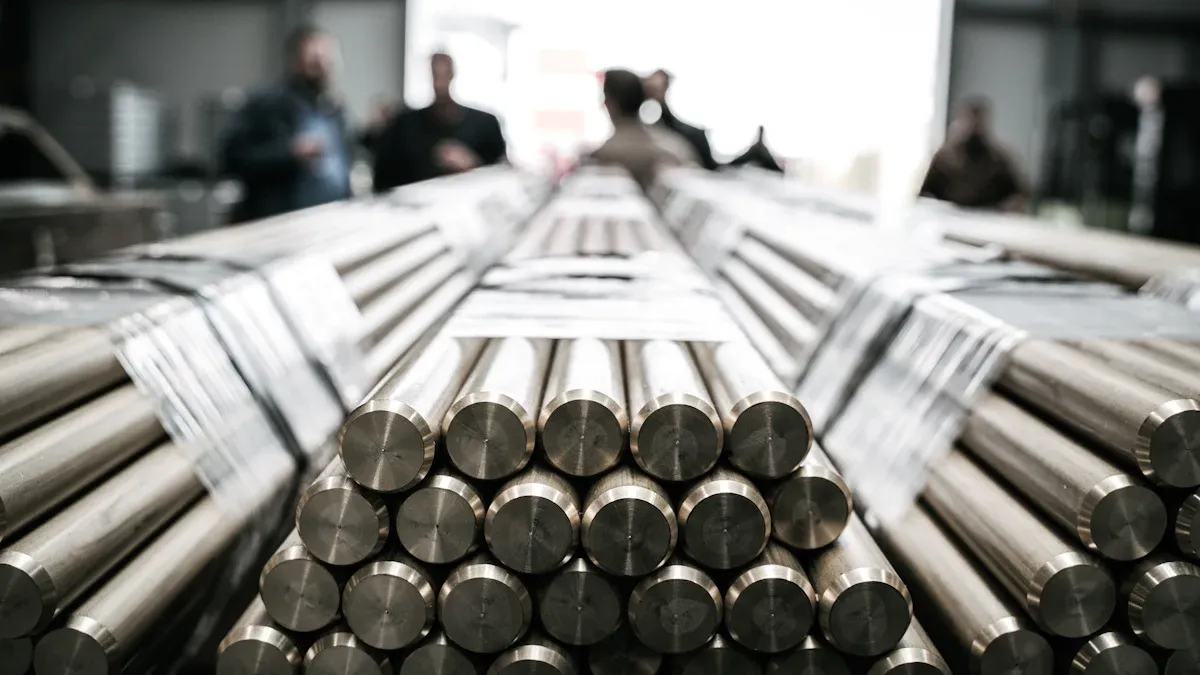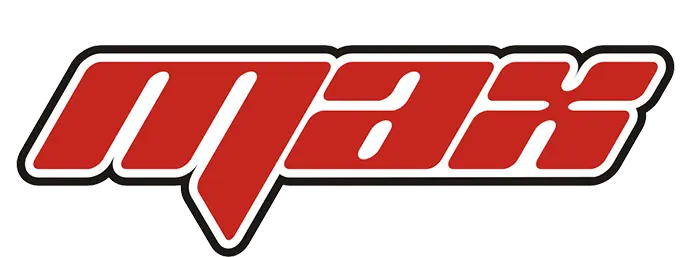
An induction hardened chrome plated rod is crafted from high-strength steel and undergoes a specialized treatment to enhance its surface hardness. After this process, engineers apply a hard chrome layer, resulting in an induction hardened chrome plated rod with exceptional durability. These rods are widely chosen across various industries for their superior corrosion resistance, as the chrome surface effectively shields against moisture and chemicals. Equipment that incorporates induction hardened chrome plated rod components benefits from reduced wear, increased strength, and extended service life. The reliable performance of an induction hardened chrome plated rod also helps minimize maintenance requirements.
Induction hardened chrome plated rod solutions help equipment last longer, even in the most demanding environments.
What Is an Induction Hardened Chrome Plated Rod?

Definition and Core Features
An induction hardened chrome plated rod is a steel rod that combines two advanced treatments. The first treatment increases the rod’s hardness, while the second adds a protective chrome layer. These rods show high strength and resist bending or breaking under heavy loads. The surface feels smooth and tough, which helps reduce friction in moving parts. Many industries use induction hardened chrome rods because they last longer than untreated rods. The combination of hardness and chrome plating makes these rods ideal for machines that need to work in tough conditions.
Key features include:
- High surface hardness for better wear resistance
- Strong steel core for durability
- Smooth, corrosion-resistant chrome finish
- Long service life in demanding environments
The Induction Hardening Process
Induction hardening uses electromagnetic energy to heat the surface of the steel rod quickly. The rod then cools rapidly, which changes the structure of the steel at the surface. This process increases the hardness of the outer layer without affecting the inside of the rod. The hard outer shell protects against scratches and dents. The steel core stays tough and flexible, so the rod does not snap easily. Induction hardened and chrome plated rods can handle repeated stress and heavy use. This process ensures that the rod keeps its shape and strength over time.
Induction hardening gives the rod a tough surface, making it perfect for high-stress applications.
The Role of Hard Chrome Plating
Chrome plating adds another layer of protection to the rod. The process covers the hardened steel with a thin layer of chromium. This chrome layer increases the rod’s resistance to rust and chemicals. Chrome plating also makes the rod’s surface smoother, which reduces friction and wear. Many machines use induction hardened chrome plated rod components because they keep working well even in wet or dirty environments. The combination of hardness and chrome plating helps prevent damage from moisture, dust, and other harsh elements.
A table below summarizes the benefits:
| Feature | Benefit |
|---|---|
| Surface Hardness | Resists wear and scratches |
| Chrome Plating | Prevents rust and corrosion |
| Strong Steel Core | Handles heavy loads |
| Smooth Finish | Reduces friction |
Key Benefits of Induction Hardened Shaft Technology
Superior Strength and Durability
Induction hardened shaft technology gives steel rods a strong outer layer. This layer protects the rod from damage during use. The process uses heat to make the surface hard, while the inside stays tough and flexible. This combination helps the rod handle high pressure and heavy loads. Many machines need parts that do not bend or break easily. Induction hardened shafts offer this strength. They last longer than regular rods because they resist dents and cracks.
Durability is important in machines that work every day. A durable rod means less downtime for repairs. Factories and workshops choose induction hardened shafts because they trust their strength and long life. These rods keep working even after many cycles of use.
Tip: Choosing a shaft with high durability can save money on repairs and replacements.
Enhanced Wear and Corrosion Resistance
Wear happens when two surfaces rub against each other. Induction hardened shafts have a hard surface that resists wear. This means the rod does not lose its shape or size quickly. The chrome plating adds another layer of protection. It keeps out moisture and chemicals that can cause corrosion. Corrosion weakens metal over time. With strong corrosion resistance, these rods stay reliable in wet or dirty places.
A table below shows how induction hardened shafts compare to regular rods:
| Feature | Induction Hardened Shaft | Regular Rod |
|---|---|---|
| Wear Resistance | High | Low |
| Corrosion Resistance | Excellent | Poor |
| Durability | Long-lasting | Shorter |
Many industries use these rods in places where wear and corrosion are common problems. The rods keep their shape and strength, even after long use.
Improved Performance in Demanding Applications
Induction hardened shafts work well in heavy-duty applications. These include construction equipment, hydraulic systems, and industrial machines. The rods keep their performance even when the job is tough. They move smoothly and do not get stuck or damaged easily. This leads to superior performance in machines that must run without stopping.
Engineers choose these rods for their reliability. The rods help machines work better and longer. They also reduce the need for frequent maintenance. When a machine uses an induction hardened shaft, it can handle more stress and keep working in harsh conditions.
Note: Reliable performance in demanding jobs means less downtime and higher productivity.
Extended Service Life and Reduced Maintenance
Induction hardened chrome plated rods offer a much longer service life than standard rods. The special hardening process creates a tough outer layer. This layer protects the rod from scratches, dents, and other damage. The chrome plating adds another shield. It keeps out moisture and chemicals that can cause rust. Together, these features help the rod last for many years, even in harsh environments.
Many factories and workshops choose these rods because they want equipment that works longer without breaking down. When a machine uses a rod that resists wear and corrosion, it does not need repairs as often. This means less time spent fixing machines and more time making products.
Fact: Studies show that induction hardened chrome plated rods can last up to three times longer than non-hardened, non-plated rods in similar conditions.
Key reasons for extended service life include:
- The hard surface resists scratches and dents.
- The chrome layer blocks rust and chemical damage.
- The strong steel core handles heavy loads without bending.
Reduced maintenance is another big advantage. When a rod stays smooth and strong, it does not need to be replaced or repaired as often. Workers spend less time checking for damage or changing parts. This saves money on labor and replacement parts.
A comparison table shows the difference:
| Feature | Induction Hardened Chrome Plated Rod | Standard Rod |
|---|---|---|
| Service Life | Very Long | Short |
| Maintenance Frequency | Low | High |
| Resistance to Damage | Excellent | Moderate |
Many industries report fewer breakdowns and less downtime after switching to these rods. Machines run smoothly for longer periods. This helps companies meet deadlines and keep customers happy.
Tip: Choosing rods with a longer service life can lower total costs and improve productivity over time.
Induction Hardened Chrome Plated Rod vs. Non-Hardened or Non-Chrome Plated Rods
Strength and Durability Differences
Induction hardened chrome plated rods stand out for their impressive strength. The induction hardening process creates a tough outer shell. This shell protects the rod from bending or breaking under heavy loads. Non-hardened rods do not have this extra layer. They can bend or deform more easily when used in machines that require high force.
Durability also sets these rods apart. The steel core inside an induction hardened rod stays flexible, while the surface remains hard. This combination helps the rod last longer in tough environments. Non-chrome plated rods often show signs of wear much sooner. Factories and workshops report fewer failures when they use induction hardened chrome plated rods.
Fact: Many tests show that induction hardened rods can handle up to 30% more stress than non-hardened rods.
Wear and Corrosion Resistance Comparison
Wear and corrosion can shorten the life of any rod. Induction hardened chrome plated rods resist both problems. The hard surface reduces friction, so the rod does not wear down quickly. The chrome plating acts as a shield against moisture and chemicals. This protection keeps rust and corrosion away.
Non-chrome plated rods lack this defense. They can rust when exposed to water or chemicals. Over time, rust weakens the rod and causes it to fail. In side-by-side tests, induction hardened chrome plated rods last much longer in harsh conditions.
| Feature | Induction Hardened Chrome Plated Rod | Non-Hardened/Non-Chrome Rod |
|---|---|---|
| Wear Resistance | Excellent | Low |
| Corrosion Resistance | Outstanding | Poor |
Maintenance and Longevity
Maintenance needs drop when machines use induction hardened chrome plated rods. These rods keep their shape and strength for years. Workers spend less time fixing or replacing them. Non-hardened or non-chrome plated rods need more frequent checks and repairs.
Longer service life means fewer interruptions in production. Companies save money on parts and labor. Many industries choose induction hardened chrome plated rods to keep their equipment running smoothly.
Tip: Investing in rods with higher durability and resistance can lead to lower maintenance costs and longer machine life.
Typical Applications for Hard Chromed Shaft Solutions

Industrial Machinery and Equipment
Factories and workshops rely on hard chromed shaft solutions for many machines. These shafts support moving parts in presses, conveyors, and machine tools. The smooth chrome surface reduces friction, which helps machines run quietly and efficiently. Workers often need to drill and tap holes in these shafts to attach other components. The hard outer layer allows for precise work without damaging the shaft. Many companies choose these shafts because they last longer and require less maintenance. The strong steel core handles repeated use, even when machines run all day.
Hydraulic and Pneumatic Systems
Hydraulic and pneumatic systems use pressure to move parts. Hard chromed shafts play a key role in these systems. The chrome layer protects the shaft from moisture and chemicals inside cylinders. This protection keeps the shaft working smoothly, even after thousands of cycles. Engineers often drill and tap the ends of these shafts to connect them to pistons or other parts. The hard surface makes this process easier and more reliable. These shafts help prevent leaks and keep systems running safely. Many industries trust them for their strength and resistance to wear.
Construction and Heavy Equipment
Construction and heavy equipment face tough conditions every day. Machines like excavators, cranes, and loaders use hard chromed shafts to lift and move heavy loads. The shafts resist bending and wear, even when exposed to dirt and water. Market data shows that agricultural equipment holds the largest share of chrome plated rod use at 35%, followed by lifting equipment at 30%. Machine tools account for 20%. The construction sector continues to grow, with U.S. spending rising by 8.2% in 2022. Asia Pacific leads the market, holding 40% of the global share. Manufacturers prefer these shafts because they last longer and reduce downtime. The strong chrome layer ensures reliable performance in harsh environments.
| Application Sector | Market Share (2023) | Notes |
|---|---|---|
| Agricultural Equipment | 35% | Largest market share |
| Lifting Equipment | 30% | Second largest share |
| Machine Tools | 20% | Significant share |
| Food Processing Equipment | N/A | Fastest growing application sector |
Note: Hard chromed shafts help construction and heavy equipment operate safely and efficiently, even under extreme stress.
Automotive, Marine, and Aerospace Industries
Automotive, marine, and aerospace industries demand high performance from every component. Induction hardened chrome plated rods play a key role in these fields. Engineers select these rods for their strength, reliability, and resistance to harsh conditions.
In the automotive sector, manufacturers use these rods in shock absorbers, steering systems, and suspension parts. The hard chromed shaft helps vehicles handle rough roads and heavy loads. Mechanics often need to drill and tap the ends of these rods to attach custom fittings or sensors. This process works well because the rods keep their shape and do not crack under pressure.
Marine environments present unique challenges. Saltwater causes corrosion in many metals. Induction hardened chrome plated rods resist rust and pitting, even after long exposure to seawater. Shipbuilders use these rods in hydraulic cylinders, winches, and steering gear. The smooth surface reduces friction, which helps moving parts last longer. Technicians also drill and tap these rods when installing them in tight spaces or connecting them to other equipment.
Aerospace engineers require materials that perform under extreme stress and temperature changes. Induction hardened chrome plated rods meet these needs. Aircraft landing gear, actuators, and control systems often rely on these rods for safe operation. The rods maintain their strength during rapid pressure changes and high-speed movement. The ability to drill and tap the rods allows for precise assembly and secure connections.
Note: Reliable components help keep vehicles, ships, and aircraft safe and efficient. Induction hardened chrome plated rods support these goals with their advanced properties.
A table below highlights key uses:
| Industry | Common Applications | Key Benefit |
|---|---|---|
| Automotive | Shock absorbers, steering, brakes | Handles heavy loads |
| Marine | Hydraulic cylinders, winches | Resists saltwater damage |
| Aerospace | Landing gear, actuators | Withstands high stress |
An induction hardened chrome plated rod offers unmatched strength, wear resistance, and corrosion protection. Many industries choose induction hardened chrome rods for machines that face tough conditions. These rods help reduce downtime and lower maintenance costs. Companies see longer equipment life and better performance. For any business that needs reliable and durable parts, these rods stand out as a smart investment.
FAQ
What makes induction hardened chrome plated rods different from standard steel rods?
Induction hardened chrome plated rods have a hard outer layer and a smooth chrome finish. This combination gives them better strength, wear resistance, and corrosion protection compared to standard steel rods.
Can these rods be used outdoors or in wet environments?
Yes. The chrome plating protects the rods from rust and moisture. Many industries use them in outdoor equipment, marine systems, and other places where water exposure is common.
How do induction hardened chrome plated rods help reduce maintenance costs?
These rods last longer because they resist wear and corrosion. Machines need fewer repairs and replacements. Companies save money on parts and labor over time.
Are induction hardened chrome plated rods suitable for custom applications?
Absolutely! Engineers can cut, drill, or tap these rods to fit specific needs. The hard surface allows for precise work, making them ideal for custom machinery and equipment.
Tip: Always use proper tools when working with hardened rods to maintain their quality.
